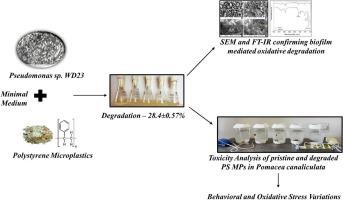Biodegradation of polystyrene microplastics by Pseudomonas sp. WD23: Toxicity assessment using freshwater snail Pomacea canaliculata
Q1 Environmental Science
引用次数: 0
Abstract
This study presents degradation of polystyrene microplastics (PS MPs) by petroleum hydrocarbon degrading Pseudomonas sp. WD23 and toxicity assessment on Pomacea canaliculata. Exposure of 100 mg/L PS MPs to Pseudomonas sp. WD23 for 42 days, led to 28.40 ± 0.57 % weight reduction, following first order kinetics with rate constant and half-life of 0.0073 day−1 and 94.95 days. Scanning electron microscopy and Fourier transform infrared spectrometry analysis revealed bacterial biofilm presence, smoothening, hole formation with confirmed oxidative degradation. Comparative toxicity of 100 and 200 mg/kg sediment of pristine and degraded PS MPs on Pomacea canaliculata was analyzed by behavior, mortality, enzymatic and non-enzymatic stress responses. Contact with pristine PS MPs caused increased reaction time with marked catalase (0.0095–0.0113 mmol/(min·mg protein)) and radical scavenging activity (73.68–78.96 %). Exposure to degraded PS MPs yielded slight catalase (0.0029–0.0032 mmol/(min·mg protein)) and moderate radical scavenging activity (63.15–65.78 %).

假单胞菌WD23对聚苯乙烯微塑料的生物降解:用淡水蜗牛Pomacea canaliculata评价毒性
研究了石油烃降解假单胞菌WD23对聚苯乙烯微塑料(PS MPs)的降解作用及对小管Pomacea canaliculata的毒性评价。100 mg/L PS MPs暴露于假单胞菌sp. WD23 42天,导致体重减轻28.40±0.57%,符合一级动力学,速率常数和半衰期分别为0.0073天和94.95天。扫描电镜和傅里叶变换红外光谱分析显示细菌生物膜的存在,平滑,孔洞形成,证实氧化降解。通过行为、死亡率、酶促胁迫和非酶促胁迫反应分析了100和200 mg/kg原生态和降解PS MPs对小管Pomacea canaliculata的比较毒性。与原始PS MPs接触,过氧化氢酶(0.0095 ~ 0.0113 mmol/(min·mg蛋白))和自由基清除活性(73.68 ~ 78.96%)的反应时间延长。暴露于降解的PS MPs中产生轻微的过氧化氢酶(0.0029-0.0032 mmol/(min·mg protein))和中等的自由基清除活性(63.15 - 65.78%)。
本文章由计算机程序翻译,如有差异,请以英文原文为准。
求助全文
约1分钟内获得全文
求助全文
来源期刊

Bioresource Technology Reports
Environmental Science-Environmental Engineering
CiteScore
7.20
自引率
0.00%
发文量
390
审稿时长
28 days
 求助内容:
求助内容: 应助结果提醒方式:
应助结果提醒方式:


